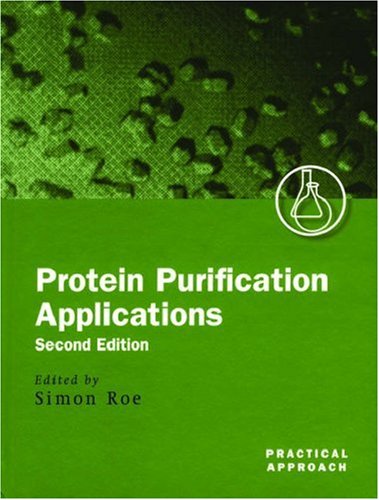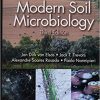Protein Purification Applications A Practical Approach 2nd Edition by Simon Roe 0199636710 9780199636716
$50.00 Original price was: $50.00.$35.00Current price is: $35.00.
Protein Purification Applications A Practical Approach 2nd Edition by Simon Roe – Ebook PDF Instant Download/Delivery: 0199636710, 9780199636716
Full download Protein Purification Applications A Practical Approach 2nd Edition after payment

Product details:
ISBN 10: 0199636710
ISBN 13: 9780199636716
Author: Simon Roe
Proteins are an integral part of molecular and cellular structure and function and are probably the most purified type of biological molecule. In order to elucidate the structure and function of any protein it is first necessary to purify it. Protein purification techniques have evolved over the past ten years with improvements in equipment control, automation, and separation materials, and the introduction of new techniques such as affinity membranes and expanded beds. These developments have reduced the workload involved in protein purification, but there is still a need to consider how unit operations linked together to form a purification strategy, which can be scaled up if necessary. The two Practical Approach books on protein purification have therefore been thoroughly updated and rewritten where necessary. The core of both books is the provision of detailed practical guidelines aimed particularly at laboratory scale purification. Information on scale-up considerations is given where appropriate. The books are not comprehensive but do cover the major laboratory techniques and common sources of protein. Protein Purification Techniques focuses on unit operations and analytical techniques. It starts with an overview of purification strategy and then covers initial extraction and clarification techniques. The rest of the book concentrates on different purification methods with the emphasis being on chromatography. The final chapter considers general scale-up considerations. Protein Purification Applications describes purification strategies from common sources: mammalian cell culture, microbial cell culture, milk, animal tissue, and plant tissue. It also includes chapters on purification of inclusion bodies, fusion proteins, and purification for crystallography. A purification strategy that can produce a highly pure single protein from a crude mixture of proteins, carbohydrates, lipids, and cell debris to is a work of art to be admired. These books (available individually or as a set)are designed to give the laboratory worker the information needed to undertake the challenge of designing such a strategy.
Protein Purification Applications A Practical Approach 2nd Table of contents:
1 Fusion protein purification methods
1 Introduction
2 Protecting proteins from proteolysis
Purification of fused APIII and release of protein using V8 protease
Isolation of EGF from tryp E-fusion using trypsin
3 Engineering to improve purification processes
Fluidized bed IMAC for polyHis-tagged proteins
Engineering metal affinity sites in somatotropins
Engineering proteins for polyelectrolyte precipitation
4 Fusions of generic application
PolyHistidine
FLAG
Recombinant phage antibody system
Fusion tag detection and purification: S-Tag system
T7-Tag affinity purification kit
Fusions based on maltose-binding protein
Intein-mediated purification with an affinity chitin binding tag
5 Concluding remarks
References
2 Initial purification of Inclusion bodies
1 Introduction
2 Mechanism of inclusion body formation
3 Isolation of inclusion bodies from cell homogenates
4 Washing of inclusion bodies
References
3 Purification for crystallography
1 Introduction
2 Methods for protein crystallization
Batch
Vapour diffusion
Dialysis
3 Influence of heterogeneity on crystallization
Effects of impurities
Origins of microheterogeneity
Detection of microheterogeneity
Additives and proteolysis
4 Concluding remarks
References
4 Protein purifications from mammalian cell culture
1 Introduction
2 Nature of recombinant proteins produced in mammalian cells
3 Transgenic animals
4 Overview of extraction and purification process
5 Process design—preventive measures
Cell culture system
Production cells
Culture medium
6 Cell separation
Purification without cell separation
7 Initial product recovery and fractionation
Recovery of recombinant protein from milk
Direct capture of product from feedstock
8 Main purification
Ion exchange chromatography
Hydrophobic interaction chromatography
Affinity chromatography systems
Small molecule affinity ligands
9 Particle-tolerant chromatographic supports
10 Purification of monoclonal antibodies
Separation using protein A
Monoclonal antibody purification by ion exchange
Other recent approaches to purification of monoclonal antibodies
11 The elimination of viral contamination risks
‘Spiking’ and the use of model viruses
Scale-down of unit operations
Calculation of virus clearance
A cautionary note
Virus removal by membrane filtration
12 Elimination of contaminating DNA
13 Other biologically active contaminants
14 Polishing steps
15 Problems
References
5 Protein purification from microbial cell culture
1 Introduction
2 Chromatographic processes
Positive or negative steps
Batch or column contactors
Gradient elution
3 Ion exchange protein purifications from microbial cell culture
Isolation of yeast enzymes
Isolation of amylase from Bacillus subtilis
Isolation of DNA-modifying enzymes
4 Ion exchange nucleic acid purification from microbial culture
References
6 Protein purification from milk
1 Introduction
2 Milk proteins
Micelle structure
Major milk protein groups
3 Factors to consider in preparation and handling milk
Source
Proteolysis
Solubility
Protein modification
Drying and storage
4 Fractionation of milk proteins
Fractionation of casein and whey
Fractionation of milk proteins by differential solubility
5 Chromatography of milk proteins
Ion exchange
Size exclusion chromatography
Affinity chromatography
Reverse-phase chromatography
Chromatofocusing
6 Identification and analysis of purity
Polyacrylamide gel electrophoresis
Isoelectric focusing
Capillary electrophoresis
Analytical chromatography
Mass spectrometry
7 Developments
Preparative electrophoresis
Microfiltration and ultrafiltration
Aqueous two-phase partitioning
Acknowledgements
References
7 Protein purification from animal tissue
1 Introduction
2 Choice of tissue
3 Tissue disruption
4 Prevention of unwanted proteolysis
5 Subcellular fractionation
6 Solubilization of membrane proteins
7 Example purifications of animal proteins
Purification of angiotensin converting enzyme
Purification of aminopeptidase P
Purification of fructose-1,6-biphosphatase
References
Appendix
8 Protein purification from plant sources
1 Introduction
2 Special considerations
Low protein concentration
Proteolysis
Inhibition and tanning
3 Source of material
Leaf
Stem
Roots
Seeds and storage organs
Fruits
Tissue cultures
Organelles
4 Direct and indirect strategies for identification of subsets of plant proteins
5 Examples of successful purification protocols: enzymes of carbohydrate metabolism
Calvin cycle 24
Polysaccharide synthases
6 Enzymes of secondary metabolism
Phenolic metabolism
Terpenoids
Alkaloids
7 Preparation for Edman protein sequencing
References
A1 List of suppliers
People also search for Protein Purification Applications A Practical Approach 2nd:
purification protoco
two step purification
protein purification akta
practical applications of pcr
Tags:
Simon Roe,Protein,Applications,Purification



